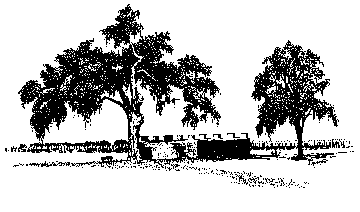Georgia, the last of the original colonies, was established, in part, to give protection to other colonies against the Spanish invasion from the south. In 1733 under James Oglethorpe’s leadership the city of Savannah was settled. The next year sailing south on the inland waterway he sought a place to build a fort. He chose St. Simons Island at the mouth of the Altamaha River approximately seventy-five miles south of Savannah.
Oglethorpe returned to America in 1736 along with 275 settlers, soldiers, and staff, including John and Charles Wesley. Part of the group stayed at Savannah and the rest, including Oglethorpe, went to St. Simons Island, where they built Fort Frederica.
Charles Wesley was Oglethorpe’s secretary and pastor to the Frederica community. His experience was so unhappy that he left St. Simons Island after two months of illness, harrassment by settlers, and disagreements with Oglethorpe. He recorded his feelings in his journal: “Sat., March 27th [1736]. I was sensibly concerned this afternoon at hearing that M.W. is growing more and more like M.H., declares she will be no longer priest-ridden, jests upon prayers, and talks in the loose, scandalous dialect of her friend. In the evening a thought came into my mind of sending Mr. Ingham for my brother. He was much averse to leaving me in my trials, but was at last persuaded to go.”
John Wesley quickly responded to his brother’s distress: “Tuesday, March 30 [1736]. Mr. Ingham, coming from Frederica, brought me letters pressing me to go hither… [Saturday, April 10]…Coming on shore [at St. Simons Island] I found my brother exceeding weak, having been for some time ill of a flux. But he mended from the hour he saw me.” All told, John Wesley made five trips to the island during his time in Georgia.
Although the Wesley brothers’ experiences in Georgia were difficult, they did establish a congregation on the island which was served by Benjamin Ingham and later George Whitefield. Today it is known as Christ Church, Frederica (Episcopal).
Fort Frederica is best known in American history for its role in the War of Jenkins’ Ear (1739-1748), when Britain and Spain battled for control of the Southeast. On July 7, 1742, at the Battle of Bloody Marsh on St. Simons Island, the troops of Fort Frederica defeated a Spanish invasion force and permanently assured that Georgia and the Carolinas would remain in British hands.
A fire in 1758 and changing military needs ended Frederica’s active life by 1763.
Points of interest at this Heritage Landmark: Fort Frederica is a National Monument of the National Park Service. There is a visitor center with a museum and visitors may tour Frederica’s ruins.
Near the fort is Christ Episcopal Church, built in 1808 on the original land grant for church use. Wesley Memorial Garden, a joint memorial to the Wesleys by the South Georgia Conference of The United Methodist Church and Christ Episcopal, is a two acre garden of native trees and shrubs across from the entrance to the fort. The United Methodist marker stands adjacent to the garden. The old military road along which Wesley walked runs between the church and garden.
The Arthur J. Moore Methodist Museum, with exhibit galleries and archival collections, is on the grounds of Epworth By The Sea, the South Georgia Conference Center.
Special events: None as of this writing.
Area attractions: The Bloody Marsh Battle site is located midway on the island and may be seen from the road. A schedule of upcoming events at Epworth By The Sea is available from the South Georgia Conference Center, P.O. Box 20407, St. Simons Island, GA 31522. John Wesley’s American Parish and the Wesleyan College Cluster are also in the South Georgia Annual Conference.
To visit: The Arthur J. Moore Methodist Museum, Library, and Archives is open daily from 10:00 am to 4:00 pm Monday through Saturday. Guided tours are available for a nominal fee and only by appointment. Please call ahead for groups of 10 or larger.
Location: Within the boundaries of the South Georgia Annual Conference, in Glynn County. St. Simons Island is seventy-five miles south of Savannah and six miles east of Brunswick on the Atlantic coast.
Food and lodging: Epworth By The Sea accommodates individuals and groups. There are also many restaurants and lodging places in all price ranges on St. Simons Island and in Brunswick.
Directions: After reaching Brunswick, Georgia, cross the F. J. Torras Causeway onto St. Simons Island and follow the signs to Sea Island Road. Continue straight through the traffic light and turn left at street marked Methodist Center Booth Gate and then left onto Arthur J. Moore Drive.
For further information, contact: The Arthur J. Moore Methodist Museum, 100 Arthur Moore Drive, Epworth By The Sea, St. Simons Island, GA 31522; Anne Packard, Curator: 912-638-4050; methmuse@bellsouth.net; Website: http://www.mooremethodistmuseum.com.
To learn more about United Methodist history in this area:
John Capon, John & Charles Wesley: The Preacher and The Poet (London: Hodder and Stoughton, 1988).
Webb B. Garrison, Oglethorpe’s folly: The Birth of Georgia (Lakemont, GA: Copple House Books, 1982).

